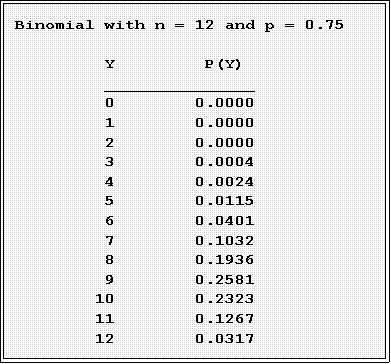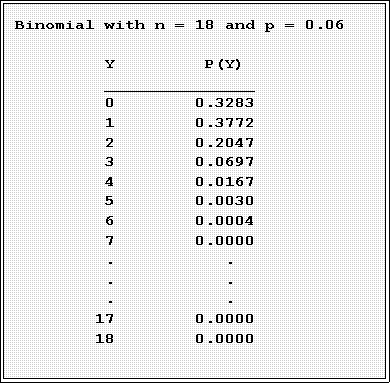DEPARTMENT OF POLITICAL SCIENCE
AND
INTERNATIONAL RELATIONS
Posc/Uapp 815
Assignment 7
NORMAL AND BINOMIAL DISTRIBUTIONS

Name___________________________
(Printed)
Student Number___________________
(Social Security Number)
E-mail__________________________
Since distributions are so essential to understanding statistical inference and since
statistical inference underlies many, many public policy debates, I want to make sure that you
know some of the ideas backward and forward. These problems, drawn from Agresti and Finlay,
are simply extensions of the kinds you did on Assignment 6, but they ask you to think a little more
about what you are doing. That is, the calculations should be straight forward, but you need to
consider carefully what they show.
- According to the Census Bureau's Current Population Reports self-employed individuals
in the United States in 1990 worked an average of 44.6 hours per week, with a standard
deviation of 14.5 hours. Assuming that hours worked is normally distributed, find the
proportion of self-employed people who averaged more than 40 hours a
week._____________ More than 50 hours per week.____________
- Suppose it is known that among women in the United States the average gestation time
until birth is 281.9 days with a standard deviation of 11.4 days. A baby is classified as
premature if the gestation period lasted less than 258 days. Assume gestation time is a
normally distributed variable.
- What proportion of babies would be born prematurely? ____________
- Now you look at a large sample of mothers from a particular rural population and
discover that the proportion of premature babies is .036. Based on these data how
would you expect the distribution of gestation time to differ from normal?
- An energy study in New York city found that in a typical month, household use of
electricity has a mean of 800 kilowatt-hours and a standard deviation of 500. The
president asks you, director of research, to convert each household's bill to a z score and
then send a letter to those that have energy use greater than 1 standard deviation above
the mean. The letter tells the customers to start turning off lights.
- What proportion (or percent) of the customers would get the letter?
_____________ Note: you should be able to answer simply by looking at the
pictures in your notes.
- Customers whose use is less than 1.5 standard deviations below the mean get a
medal. What proportion or percent of households can expect to get this reward?
_____________
- (Based on Agresti and Finlay, Statistical Methods, problem 6-11 (page 200).) The 1994
General Social Survey asked "Do you think it should be possible for a pregnant woman to
obtain a legal abortion if the family has a very low income and cannot afford any more
children?" A pro-life group claims that only a minority of Americans, no more than 20
percent, support such a position. But you take a random sample of 12 people in your
voting district and find that 7 agree with the statement. Is there any evidence that the
group underestimates support for abortion in the case of family economic hardship? Use
the information in the two tables to answer these questions. You should be able to figure
out which table is appropriate by thinking briefly about the question.
- If the pro-life group is correct, what is the probability of getting exactly 7
"agreements"?_____________
- In the same situation, what is the probability of getting 7 or more agreements?
That is, what is the probability that 7 or 8 or 9... people will agree? (Note: just add
probabilities.) ____________
- What is the probability that if the group is correct you would find 2 or fewer
agreements or 11 or 12 agreements?___________ (Again, add the probabilities.)
________________
- Assume that the group is wrong and that 75 percent of Americans accept the
proposition. Now what is the probability of getting exactly 7 agreements?
___________ What is the probability of getting 7 or more agreements? _______


- The authorship of an old document is in doubt. A historian hypothesizes that the author
was a journalist named Jacalyn Levine. Upon a thorough investigation of Levine's known
works, it is observed that one unusual feature of her writing was that she consistently
began 6% of her sentences with the word whereas. To test the historian's hypothesis, it is
decided to count the number of sentences beginning with the word whereas. As
preliminary step the historian takes a random sample of 18 sentences and finds that none
of them start with the word in question. What conclusions can you draw? Use the table
below to help you answer, which incidentally does not contain all of the possible sample
results because as you can see their corresponding probability is 0. (Your answer should
include the probability of the sample result and a substantive conclusions.(1)
- ________________________________________________________________________________________________________________________________________________________________________________________________________________________________________________________________________

1. As Agresti and Finlay note, this problem
is based on a study conducted by F. Mosteller
and D. L. Wallace, Inference and Disputed Authorship:
The Federalist (Addison-Wesley,
1964).

 Go to Statistics 815 main page
Go to Statistics 815 main page
 Go
to H. T. Reynolds page.
Go
to H. T. Reynolds page.



 Go to Statistics 815 main page
Go to Statistics 815 main page